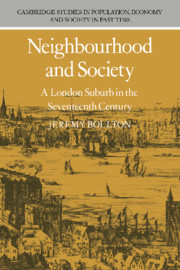Book contents
- Frontmatter
- Contents
- List of figures
- List of tables
- Preface
- Abbreviations
- 1 Introduction
- 2 The demographic background
- 3 Earning a living in early seventeenth-century Southwark
- 4 Wealth and social structure
- 5 Household structure and the household economy
- 6 Power, status and social mobility
- 7 Residential patterns and property ownership
- 8 The dynamics of a local community
- 9 Social relationships in the urban neighbourhood
- 10 The institutional structure of the neighbourhood
- 11 Conclusion: neighbourhood and society in seventeenth-century London
- Bibliography
- Index
10 - The institutional structure of the neighbourhood
Published online by Cambridge University Press: 19 October 2009
- Frontmatter
- Contents
- List of figures
- List of tables
- Preface
- Abbreviations
- 1 Introduction
- 2 The demographic background
- 3 Earning a living in early seventeenth-century Southwark
- 4 Wealth and social structure
- 5 Household structure and the household economy
- 6 Power, status and social mobility
- 7 Residential patterns and property ownership
- 8 The dynamics of a local community
- 9 Social relationships in the urban neighbourhood
- 10 The institutional structure of the neighbourhood
- 11 Conclusion: neighbourhood and society in seventeenth-century London
- Bibliography
- Index
Summary
Local government: the framework and supervision of the neighbourhood
The previous chapter described the local basis of many social relationships in the Boroughside district. It was also noted, however, that urban communities are often thought to have been reinforced and bonded together by participation in and by the action and pervasiveness of formal institutions of government – bodies holding political, administrative or economic power. The extent and importance of office-holding and membership of craft fellowships has been described recently in sixteenth-century York and Coventry. In sociological terms too, local social systems are thought more likely to develop (and be preserved in times of social stress) in the presence of enduring political, legal and economic organisations.
Office-holding and the pervasiveness of local government has also become a central feature in an interpretation of seventeenth-century London which chooses to emphasise social stability and communal obligation in the capital. Valerie Pearl has suggested that the key institutions of the wardmote and the vestry, which made up the local government of the capital, may have been responsible for its social stability in the early seventeenth century. There was, notably in the wealthier wards, a high proportion of local officials to rate-paying householders. In Cornhill in the 1640s there were 118 officers to serve 276 householders. In the poorer ward of Farringdon Without (the largest in the City) there was one official for every eighteen householders.
- Type
- Chapter
- Information
- Publisher: Cambridge University PressPrint publication year: 1987

